Nomentano
Bridge (in Italian:
Ponte Nomentano), also called "Old Bridge" (in
Italian: Ponte Vecchio), is a symbol of Rome's neighborhood
of Montesacro, both for its long
history, both for its beauty,
which is evident for those who admire it from the modern Tazio
bridge, the main entrance to
the neighborhood from the center (the view is only for those who
pass on foot or by bus, riding in a car you can't see it).
The bridge lies at the foot of the historic Monte Sacro hill,
and allows Nomentana road to pass over river Aniene (formerly
named Anio, later Teverone), a left tributary of the Tiber.
The bridge was built in Roman times, and since then it has undergone
many changes, both due to the destruction caused by floods or
wars, and because, since the Middle Ages, it was fortified for
its crucial position on a strategic and military point of view.
For centuries, in fact, the bridge was one of the few entrances
to Rome for those who came from the north (like most of the invading
armies), together with Salario and Mammolo bridges, on the Aniene,
and Milvio, on the Tiber.
This character of small fortress is quite clear to those who cross
the bridge, along the narrow passage
of the Via Nomentana, which runs confined between two walls, that
link two towers at their ends and are surmounted by balconies.
The considerable distance from the city walls (about four kilometers,
2.5 miles) meant that until the '20s of the twentieth century
the bridge was isolated in
the countryside, and not surrounded by any village.
The bridge was often cited as "Lamentano", as
the estate in which it arose, but it was also called "juxta
Casale de Pazzis", meaning "near Casal de 'Pazzi"
for its proximity (1.2 km, 0.75 mi) with the estates and the still
existing residence of the
noble Florentine family de' Pazzi.
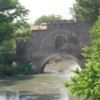
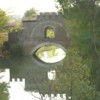
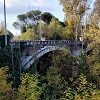
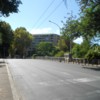
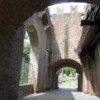
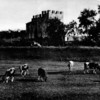
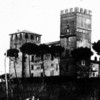

Besides being a fortress, the bridge was particularly important for the transit of flocks and herds engaged in transhumance, and in actual fact, on the keystone of its upstream arch a relief can be seen, representing a club upside down, symbol of Hercules, protector of livestock, and a stylized bovine head, while the downstream arch (the one facing Tazio bridge) represents a straight club. Even other herds' crossing places of Tiber and Aniene river were sacred to Hercules (Calci). In 1532, under Pope Clement VII de' Medici (1523-1534), Nomentano bridge passed, like others, to the city customs and, together with Mammolo and Salario bridges, assumed the role of "Livestock Customs", for the collection of duties on cattle transit (so much per head) needed for transhumance, as in many other areas of south-central Italy, and as in ancient Rome. Actually Varro speaks of a tax (scriptura censoria) on transhumant herds and flocks, paid for the use of sheep tracks (calles publicae) and collected by agents (stationarii) in fixed passages, such as bridges (Grenier).
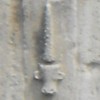
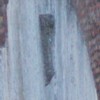

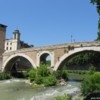
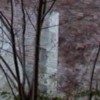
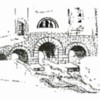

The bridge
as it was
Recent studies by Lorenzo Gigli and Stefania Quilici Gigli allowed
to enlighten the history of Nomentano bridge, dating it around
100 BC by its construction technique, the materials used and in
particular for the style of the bovine head represented on the
keystone. Previously, anyway, an older bridge had to be in place,
allowing Via Nomentana, formerly via Ficulensis, to cross
the river.
According to Quilici and Quilici Gigli the bridge had originally
a double archway with 15.1 meters (49.5 ft) span, 6 meters (19.7
ft) wide central pier and a smaller flood outflow arch of 3 meters
(9.8 ft). The look was therefore similar to that of Fabricius
bridge, on Tiberina island. The arch which went lost was on
the Rome side and was probably destroyed by Totila (see below),
and the subsequent rebuilding replaced it with a ramp.
The accuracy of this reconstruction is confirmed by the remains
of an impost in
travertine opus quadratum (square blocks masonry) in the
downstream pier on the Rome side, made of blocks of 55-60 cm (2
ft approx.) in height, embedded in the medieval brick wall, likely
a jamb of the flood outflow arch.
The pillars of the arches, heavily refurbished by subsequent works,
were made in rectangular blocks of red lithoid tufa, laid in alternate
rows of stretchers and headers, that can partly still be seen
on the Monte Sacro side, with travertine archivolts.
According to other reconstructions, the original structure had
three arches, with the central being wider of the side ones; according
to some representations the arches of the ramp on the Rome side
were two, while other ones showed two arches on each side. In
a sketch made
by Fra Giocondo (1433-1515) the
bridge has three main arches, the central of which is wider, and
also shows three small ramp arches on the side facing Rome.
The bridge
as it is
The bridge is 7.35
m (24.1 ft) wide, 60 m (197 ft) long, with a single archway of
15.1 m (49.5 ft), with fronts in travertine ashlars and intrados
in Gabii lithoid tufa, topped by a fifteenth-century fortress,
with swallow-tailed merlons, consisting
of a watch-turret on the side
of Rome, to protect access to the city, and a lower
building, a remnant of a collapsed twin tower, covered by
a roof, perhaps in the eighteenth century (Calci). The two turrets are joined by two walls
with crenellated running balconies supported
by travertine corbels, where
two large arched windows
open on both sides, with a 3.8 m (12.5 ft) width. Over each window
a wide discharging arch of 13.8 m (45.3 ft) in diameter stands,
with an arched brickwork lintel. On both sides of the turrets
two other smaller towers stand, dating to the mid fifteenth century
restoration.
The 8 meters wide piers, as above mentioned preserve parts of
the original Roman structure in red lithoid tufa. On both sides
of the main arch two lateral ramp arches stand, 3.0 (9.9 ft) and
3.3 (10.8 ft) meters wide, built in Roman concrete (opus caementicium)
including reused materials (marble, bricks, flint, tufa blocks)
with arched lintels in fragmented ancient bricks. In the intrados
of the arches, made of tufa and flint rubbles, the imprint of
the reeds that coated the centring used for the construction of
the arch can be seen. The masonry technique used for the small
arches dates them to the Pope Adrian restoration of VIII century.
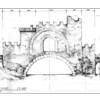
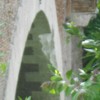
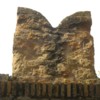
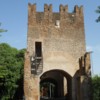
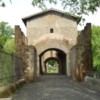
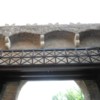
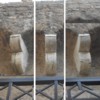
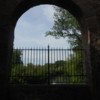
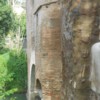
On the upstream versant,
Montesacro side, a sixteenth century hanging latrine
stands, with finely decorated reused Renaissance corbels,
rebuilt in the mid-nineteenth century. The upstream side is composed
of a well-cured masonry of reused bricks which, by comparison
with similar artifacts, is attributable to the sixth century restoration
(Quilici,
Quilici Gigli, Calci).
In several ancient artistic representations the remains of an
avant-corps are
portrayed, standing a few meters ahead of the front of the bridge,
on the Monte Sacro side, which must have been demolished in late
'700 or early '800, perhaps to facilitate the passage of vehicles.
The first
millennium of the bridge
The Byzantine historian
Procopius of Caesarea tells (History of the Wars, VII, 24, IV)
that in 547, during the Greek-Gothic war (535-553), the King of
the Goths Totila, before leaving Rome to the Emperor's army, to
find shelter in Tivoli , destroyed all the bridges on the Tiber,
except for Milvio bridge, which
was too close to the city. Since the other bridges on the Tiber
were inside the city, and therefore even closer than Milvio bridge,
probably the bridges which were destroyed, mentioned by Procopius,
were those more peripheral, crossing the Aniene, then Nomentano,
Salario and Mammolo bridge. The bridges were rebuilt entirely
in travertine in 552 by Narses, the
Byzantine general of Armenian origin, who ruled Rome on behalf
of the Emperor Justinian.
Pope Adrian I, during his pontificate (772-795) ordered the restoration
of many buildings, including Nomentano bridge, which was fortified
with a crenellated tower at each end, through which the road passes,
connected by wooden balconies, joined by a wall with large arched
windows and a crenellated gallery, resting on finely decorated
corbels, occupied by guardrooms.
On 24th November 800 the bridge was probably
the scene of the meeting between Pope Leo III and Charlemagne,
who came down to Rome to defend the Pope from the attacks of his
opponents; the Pope then crowned him, perhaps in spite of his
will, "Great Peaceful Emperor of the Romans",
in St. Peter's Basilica, on Christmas Eve of that year.
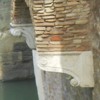
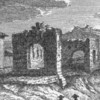
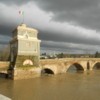
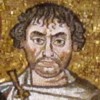
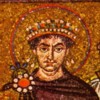
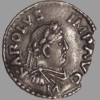
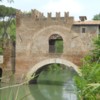
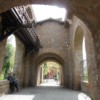
The second
millennium of the bridge
In the tenth century the bridge belonged to San Silvestro in Capite
monastery, in 1205 it passed to San Lorenzo in Lucina church and
then to San Pietro in Vincoli (Saint Peter in Chains) monastery,
together with the estates of Sant'Agnese fuori le Mura (Saint
Agnes Outside the Wall) Basilica. In the twelfth and thirteenth
centuries the structure of the bridge was superelevated and reinforced
with flint flakes masonry.
The bridge was occupied and damaged in 1433 by Niccolò
Fortebraccio della Stella and Antonio Gambacorta count of Pontedera,
in their fight against Francesco Sforza, heading to the conquest
of Rome, and in 1452 Pope Nicholas V Parentucelli (1447-1455),
as part of a full program of restoration and reconstruction, financed
with the proceeds of the Jubilee of 1450, ordered an intervention
that gave the bridge its current look, with the solid central
frame, and superelevating the towers and putting two strong security
doors. The hinges of the doors on Monte
Sacro side are still in place. The intervention is remembered
by a plaque on the side of Rome bearing the emblem of the pope
and the inscription N PAPA V (Nicolaus
Papa V), which was ironically interpreted by common people as
"Nessun papa volemo" ("No pope we want").
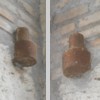
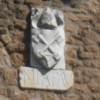


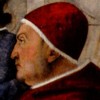



The bridge was restored
under several popes: in 1460 Pius
II Piccolomini (1458-1464) ordered works on double battlements,
balconies with reused decorated corbels and inner shutters, completed
in 1471 by Pope Paul II Barbo (1464-1471).
Later Sixtus IV della Rovere
(1471-84) intervened, and fixed a bridges toll, in order to fund
their restoration and maintenance, needed especially for those
on the Aniene, which were isolated and therefore more exposed
than urban ones to raids and assaults by the enemies.
Sixtus IV appointed as Guardian of the bridge his nephew Giuliano
della Rovere, cardinal with the title of San Pietro in Vincoli,
future pope Julius II, who received
the income from the bridge tolls. (Malizia)
Innocent VIII Cybo (1484-1492) and Alexander
VI Borja (1492-1503) ordered to restore towers, rebates and
battlements, to repair the damage followed to the occupation in
1485 by the Aragonese troops led by Paolo Orsini, and the reconquest
by the Anjou supported by Innocent VIII.
On January 18th, 1503 Pope Alexander VI, Rodrigo
Borja, instigated by his son Cesare, known as Valentino, had Paolo
Orsini killed, after luring him to Senigallia by deception. In
revenge, Fabio Orsini, Paolo's son, in the same month attacked
the Spanish troops loyal to the Borjas near the Nomentano bridge
and destroyed them (Malizia).
Paul III (1534-1549), intervened in 1546 making the access arches
lower, further works were ordered by Sixtus V Peretti (1585-1590)
and Innocent X Pamphili (1644-1655),
who rebuilt the bridgeheads facing Rome, fixing his coat of arms
on the right side of it. The coat of arms was stolen years ago
and in its place the City Council placed a copy.
In 1534 the bridge was mentioned by Bartolomeo Marliano (d. 1560)
in his Topografia della Città
di Roma and in 1558 by Lucio Mauro in Antichità
de la Città di Roma.
The Catasto Alessandrino (Land Registry of Pope Alexander VII)
on a map dated February
3rd, 1636 (link)
reports the bridge together with Iacobacci tower, indicating Domenico
Jacobacci as owner. The Iacobacci tower can be probably identified
with the mausoleum which
is located just over the bridge (see page, in construction), which
in the Middle Ages was fortified and reinforced with a tower on
its top. In 1704 the bridge is shown in the Topografia dell'Agro Romano by Giovanni Battista Cingolani della Pergola
and in the same period the collapse of the upper part of the tower
on the right bank is documented, then replaced by a lower building
with slope covering, still existing. Giuseppe Antonio Guattani
in Roma Antica (1795) briefly
speaks of the bridge.
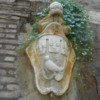
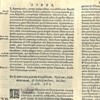
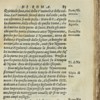
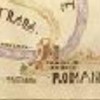
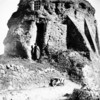
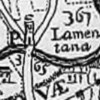
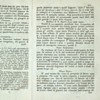
The Nomentano
bridge in the nineteenth century
The great French author Stendhal (Henri
Beyle, 1783-1842), in his work Promenades dans Rome, tells of a trip on April
18th 1828 to Monte Sacro, which led him to cross
Nomentano bridge and see the sepulchre
that was mistakenly referred to him as the burial of Menenius
Agrippa.
In 1849 the bridge was broken by the French troops of General
Oudinot for a length of seven meters to prevent Giuseppe
Garibaldi's Redshirts, camped in Monterotondo to enter Rome.
The passage was restored in 1857 by architect Francesco Fontana,
who also provided to restore the battlements of the towers, the
extrados, the bridgehead facing Monte Sacro, and the paving.
On October 29th, 1867, on the occasion of Garibaldi's
new attempt to conquer Rome, the general was assured that the
Romans were ready for an insurrection, so he reached and occupied
the Casal de' Pazzi with some men, at a short distance from the
bridge, hoping to push the Romans to rise up with his presence.
A handful of Garibaldi soldiers, led by the officer Ferdinando
Gregori, had a firefight with the papal soldiers at the Nomentano
bridge. Garibaldi, realizing that the insurrection would not take
place, the next day returned to his troops in Monterotondo. The
bridge was again interrupted, and on November 3rd
Garibaldi was defeated in Mentana, by the papal Zouaves under
the command of General Hermann Kanzler, and by the French troops
of Baron de Polhés, who had just landed in Civitavecchia
in aid of Pope Pius IX.
A few years later, in the winter of 1875, Garibaldi, who had become
deputy of the Italian Parliament, probably crossed Nomentano bridge
to reach the villa Cavallini
in via Nomentana which now hosts Marymount School, near the Basilica
of St. Agnes, where a plaque
commemorates his stay.
At the turn of the '800 and '900 the bridge area was the scene
of fox hunts
envolving Roman enthusiast,
both belonging to the aristocracy and to the upper class, with
the participation of English residents in Rome. The bridge was
also used by the fox hunting teams to pass through and reach Vigne Nuove, another site which was
appreciated for this activity.
In 1886, on the back of the Osteria
de' Cacciatori (Hunters' Tavern), 150 m from the bridge, the
base of a mausoleum and the remains of an imperial age villa were
found, with a double vault piscina, which likely extended itself
as far as the slopes of the Monte Sacro, and to which a 15 meters
(50 ft) long reservoir, found nearby, probably belonged.
On Sunday January 27th, 1889 the Roman republicans organized
a demonstration (see my
webpage on this) to commemorate Garibaldi's victory in
the battle of Dijon, on January 23rd, 1871, during the Franco-Prussian
war. A march started from Piazza Indipendenza, walked along Via
Nomentana, and reached the Osteria dei Cacciatori, of Filippo
Averardi, next to the Nomentano bridge, to also remember the battle
between Garibaldi and Papal troops in 1867. The march and the
demonstration at the bridge had decidedly a republican characters,
with shouts against the monarchy and the Italian flags with the
"frog", that is with the Savoy coat of arms in the center
were lowered. The speech was interrupted by the police, due to
its anti-monarchical content, but the crowd reacted by throwing
stones, sticks and glasses from the top of Monte Sacro hill. Police
reinforcements attacked the demonstrators on their return to the
city, passing through Porta Pia, with excesses of brutality, causing
many injuries (Il
Messaggero).
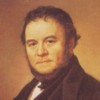
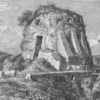
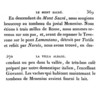

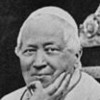
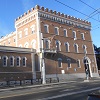
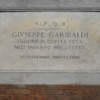
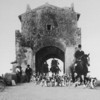

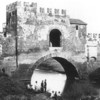
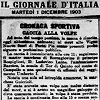
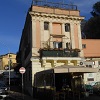
Ponte
Nomentano in 20th century
In 1935 the new Tazio bridge was inaugurated, about two hundred
meters downstream of Nomentano bridge, served by Via Nomentana
Nuova, a detour of Via Nomentana, then named Via Ponte Tazio,
that allowed traffic, including at that time the tram, to bypass
the old bridge reaching Piazza Sempione from city center. In 1926,
due to threats to its stability, the first lesser span on the
right bank was filled in. Despite the construction of Tazio bridge,
the Nomentano bridge, in the meantime renamed by the people "Old
Bridge", continued to be used, at first with an alternate
one-way, with a rudimentary hand-operated set of traffic lights,
and then with a one-way for traffic coming from Rome; the bridge
was the scene of traffic accidents, even fatal, for the sudden
narrowing and the sharp right turn, that caused the cars who got
onto the bridge at an excessive speed, to crash into the wall
that protected the left parapet. In 1979 gratings to protect the
two windows and parapets on the smaller arches were installed.
In 1997 the bridge was very appropriately closed to traffic, and
it's now accessible only to pedestrians, and in 2000, on the occasion
of the Jubilee, it has been restored and is now included in the
Natural Park of the Aniene Valley, and continues after
centuries withstanding floods.
In 2020 Nomentano Bridge was in 228th
place with 1752 votes in the ranking of Luoghi
del Cuore (Places of the Heart) organized by the FAI
(Fondo Ambiente Italiano, see
website) the Italian Fund for Environment.
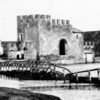
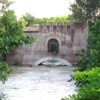

Ponte
Nomentano in the arts
In addition to being crossed over the centuries by many historical
figures, the Nomentano bridge has also inspired many artists,
especially painters and engravers as Israel
Silvestre (1621-1691), Hendrik
Frans Van Lint (1684-1763), Ridolfino
Venuti (1705-1763), Giuseppe
Vasi (1710-1762), Richard
Wilson (1713–1782), Joseph
Wright of Derby (1734-1797), Domenico Pronti (1750- ca.1815)
see the mosaic from
his engraving, James
A. Merigot (1760–1824), Agostino
Tofanelli (1770-1834), J.
Christian Erland (?), Luigi
Rossini (1790-1875), Achille
Parboni (1783-1841), Giovanni
Brun (1754-1800), Camille
Corot (1796-1875), Antonio
Acquaroni (1801-1874), Karl
Eduard Biermann (1803-1892), Charles
Coleman (1807-1874), Johann
Wilhelm Schirmer (1807-1863), Pierre-Nicolas
Brisset (1810-1890), Francis
Wey (1812-1882), Jean-Achille
Benouville (1815-1891), Felix
Benoist (1818-1896) also with Eugène
Cicéri, (1813-1890), Jules
Laurens (1825-1901), Robert
Burn (1829-1904), Carlo Ferranti
(1840-1908), Albert
Hertel (1843-1912), Francesco
Coleman (1851-1918), Harold
Broadfield Warren (1859-1934), Filippo
Anivitti (1876-1955), Costantino
Vetriani (1885-1968) and Adolfo
Scalpelli (1888-1917), in addition to the photographies by
Giuseppe Primoli (1851-1927).
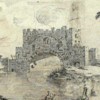
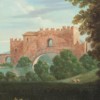
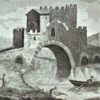
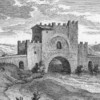
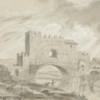
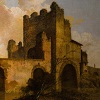
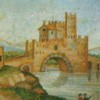
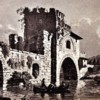
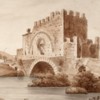
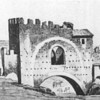
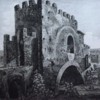
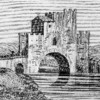
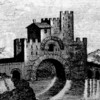
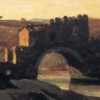
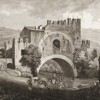
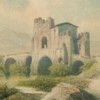
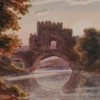
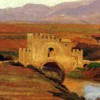
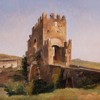
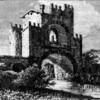
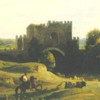
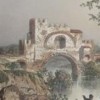
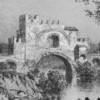
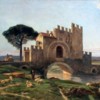
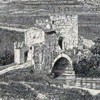
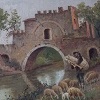
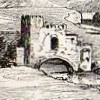
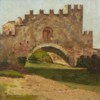
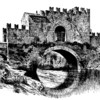
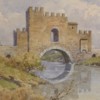
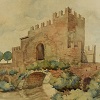
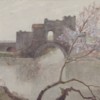
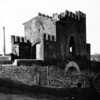
How to
get there
The bridge is located in Montesacro neighborhood, and can be reached
from the center of Rome along Via Nomentana, about 3.8 km (2.4
mi) from Porta Pia, then taking the detour on the right which
leaves via Nomentana, right after the intersection with Via Bencivenga
(on the right) and via Val Trompia (on the left). Actually the
detour is the via Nomentana, while the road going straight is
via Nomentana Nuova. The old and new via Nomentana are separated
by a small pine grove. The bridge can
also be reached by bus from the city center with the lines 60
(from piazza Venezia), 66, 82 and 90 (from Termini Railway Station),
and from Pietralata (metro B) with the line 211. The nearest metro
station is Conca d'Oro (B1 line, direction Ionio) at about 800
meters (0.5 mi). The bridge can also be reached from Montesacro
by Piazza Menenio Agrippa,
going down via Nomentana for about two hundred meters.
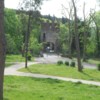

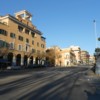
BIBLIOGRAPHY:
AA.VV.
- Atti delle Giornate di studio sul Suburbio romano "Suburbium"
Dalla crisi del sistema delle ville a Gregorio Magno. Roma,
16-18 marzo 2000.
CALCI Carmelo - Il libro di Roma Archeologica. ADN
Kronos Libri, Roma, 2000.
CARPANETO Giorgio - Quartiere XVI Monte Sacro. In: I Rioni
e i Quartieri di Roma. Newton Compton Editori, Roma, 1991, pag.
1993-2016.
CINGOLANI Giovanni Battista - Topografia geometrica dell'Agro
Romano. Stamperia di Domenico de Rossi, Roma, 1704. link
COEN Paolo - Le magnificenze di Roma nelle incisioni di Giuseppe
Vasi Newton Compton Editori, Roma, 1996.
GARIBALDI Giuseppe - Memorie. Bietti, Milano, 1932.
GRENIER Albert - La transhumance des troupeaux en Italie et son
rôle dans l'histoire romaine. Mélanges d'archéologie
et d'histoire, 1905, 25: 293-328.
LANCIANI Rodolfo - Pagan and Christian Rome. Houghton, Mifflin
and Company, Boston and New York, 1893.
MALIZIA Giuliano - I ponti di Roma - Antichi e moderni, esistenti
e scomparsi. Newton Compton editori, Roma, 1994.
PROCOPIO DI CESAREA - La guerra gotica. (translation by Domenico
Comparetti). Editori Associati, Milano, 1994.
QUILICI Lorenzo, QUILICI GIGLI Stefania (editors) -
Strade romane, ponti e viadotti. "L'Erma" di
Bretschneider, Roma, 1996.
QUILICI GIGLI Stefania - Roma fuori le mura. Newton Compton
editori, Roma, 1980.
REGGI Alessandra - Ponte Nomentano. Atlante dei Beni Culturali
delle Aree Naturali Protette di RomaNatura. Gangemi Editore,
Roma, 2010 link
SOVRINTENDENZA
CAPITOLINA AI BENI CULTURALI - Ponte Nomentano. link.
STENDHAL
- Promenades dans Rome. Delaunay, Paris, 1829.
TOURING CLUB ITALIANO - Guida d'Italia. Roma e dintorni. Arti
Grafiche Alfieri & Lacroix, Settimo Milanese, 1965.
LINKS
http://lupa.biblhertz.it
Digital collection
of journals of the National Central Library of Rome (Il Giornale
d'Italia, Il Messaggero) link
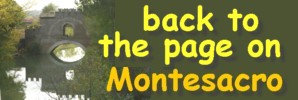
 page
created: June
26th 2015 and last updated:
March
15th, 2024
page
created: June
26th 2015 and last updated:
March
15th, 2024